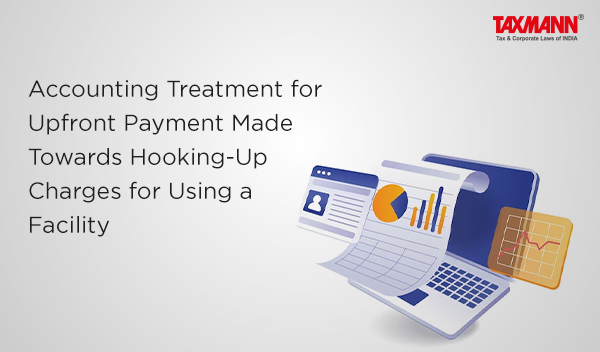Accounting Treatment for Upfront Payment Made Towards Hooking-Up Charges for Using a Facility
- Blog|News|Account & Audit|
- < 1 minute
- By Taxmann
- |
- Last Updated on 28 November, 2023
A company has entered into a hooking-up agreement with the transporter to distribute the gas throughout the city. The agreement is valid for 10 years and requires the company to make an upfront payment at the time of inception of the agreement. Further, under the hooking-up agreement, transporters have required the contractor to construct, install, test, calibrate, and commission the metering facility, gas monitoring equipment, pressure regulators, filters, telemetry, and all hooking-up facilities in accordance with the requirement of operating conditions of the Company at the cost of an upfront payment.
Further, the transporter does not hold any substantive substitution right as, such assets were created for the exclusive use of the company, which also possesses the right to control and direct use of identified assets.
Under the old GAAP framework, the accountant of the company has classified these hooking-up payments as ‘Prepaid Expenses’ under the heading of ‘Other Non-Current Assets’ and amortizes the same in the Statement of Profit and Loss based on the life of the Agreement.
The accountant faces the dilemma of classifying this hook-up consideration while adopting the Ind AS framework whether as a “Lease” under Ind AS 116 or an “Intangible Asset” under Ind AS 38. Click to read the correct classification of the hook-up agreement in the extant case.
Click Here To Read The Full Story
Disclaimer: The content/information published on the website is only for general information of the user and shall not be construed as legal advice. While the Taxmann has exercised reasonable efforts to ensure the veracity of information/content published, Taxmann shall be under no liability in any manner whatsoever for incorrect information, if any.

Taxmann Publications has a dedicated in-house Research & Editorial Team. This team consists of a team of Chartered Accountants, Company Secretaries, and Lawyers. This team works under the guidance and supervision of editor-in-chief Mr Rakesh Bhargava.
The Research and Editorial Team is responsible for developing reliable and accurate content for the readers. The team follows the six-sigma approach to achieve the benchmark of zero error in its publications and research platforms. The team ensures that the following publication guidelines are thoroughly followed while developing the content:
- The statutory material is obtained only from the authorized and reliable sources
- All the latest developments in the judicial and legislative fields are covered
- Prepare the analytical write-ups on current, controversial, and important issues to help the readers to understand the concept and its implications
- Every content published by Taxmann is complete, accurate and lucid
- All evidence-based statements are supported with proper reference to Section, Circular No., Notification No. or citations
- The golden rules of grammar, style and consistency are thoroughly followed
- Font and size that’s easy to read and remain consistent across all imprint and digital publications are applied








 CA | CS | CMA
CA | CS | CMA


